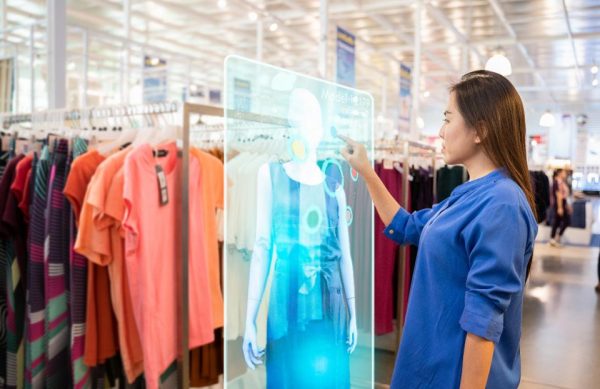The Top 10 Technology Trends In Retail: How Tech Will Transform Shopping In 2020 – Forbes
Technology is changing the way every industry does business by helping to create efficiencies, save money, and provide better products and services. Retail businesses are also adopting technology to their advantage. Here are 10 of the top tech trends that will transform shopping.

The Top 10 Technology Trends In Retail: How Tech Will Transform Shopping In 2020
Adobe Stock
Extended Reality
Virtual and augmented reality offer retailers several ways to enhance the customer experience. From browsing products to virtually “trying them on,” extended reality is already in use by many retailers today. Teen surf and sports clothing retailer Tilly’s offered its customers a back-to-school scavenger hunt experience that helped their customers explore different clothes and accessories. Extended reality can also provide additional information for customers when they are browsing for products such as the “Living Wine Labels” from Treasury Wines Estates. The IKEA Place ARKit app helps you determine if the furniture you want to purchase will fit and look good in your home. In the future, extended reality will eventually enable consumers to be able to share their virtual reality shopping experience with others.
Predictive Analytics (Big Data)
Retail organizations have never had an issue collecting lots of data, but analyzing it and using the data to solve problems or create new solutions has been a struggle. Predictive analytics changes that. Now retailers can be proactive about the future by analyzing consumer behavior and trends from the past. When retailers successfully analyze data, they are able to understand important information about consumer purchasing behavior, personalize the shopping experience, address a consumer’s needs based on where they are in the customer journey, improve efficiencies and reduce costs of supply chains and more. Predictive analytics helps retailers be smarter, more efficient, and reduce costs.
Micro Moments
Think about how you use Google or your favorite search engine. You rely on finding what you need in the moment, whether that’s for a celebration, how to fix something or solve a problem like where to find a restaurant to satiate your hunger for Italian food. Retailers who can meet customers “in the moment” have a powerful advantage. Thanks to direct digital access to consumers and powerful analytics capabilities, businesses can capture moments and help customers during their moment of need and even anticipate what a customer might need before they even know it.
Recommendation Engines
Another powerful tech tool for retailers is recommendation engines that help customers find things they never knew they needed and to help funnel options to a consumer at relevant times in their shopping journey. Recommendation engines get better over time. The more data the algorithms have to assess a customer’s shopping behavior, the better the recommendations. Retailers get to benefit from higher cart sales and improved customer satisfaction thanks to the ease of use. Amazon, Netflix, and Spotify are the recommendation engines you might be most familiar with, but many other retailers such as Best Buy use them too.
Order Fulfilment Automation
By the end of 2025, more than 580,000 autonomous mobile robots (AMR) will be deployed to help warehouses fulfill customer orders. Many retailers are scrambling to adjust to the “Amazon Effect” and are exploring order fulfillment automation to try to increase the speed and flexibility of operations in order to compete with Amazon. This automation can significantly reduce order processing times. In addition, warehouses have struggled to find enough human laborers to keep up with demand, so automated systems are an attractive solution.
Face Recognition
Many of the most successful retailers have online and offline presences. Facial recognition technology helps retailers proactively battle shoplifting and retail crime. In addition, it can bring the personalized online shopping experience to the brick-and-mortar location. When a customer is identified through facial recognition technology, the store staff can better respond to that customer’s unique needs. There are certainly legal and privacy concerns to be worked out, but there are several advantages for retailers who adopted facial recognition technology.
Stock Management
Automated warehouses help improve inventory control. Rather than wait for manual inventories, smart robotics and computer systems keep reliable stock data in real-time. This accurate data helps retailers manage stock flow, make solid predictions, smart decisions, and forecasting that help improve the store’s bottom line. Better inventory management of raw, in-process, and finished goods reduces waste, spoilage, and even theft.
Robotic Store Assistants
Another tech trend that’s changing shopping is robotic store assistants. Robots like Pepper can help shoppers find the merchandise they are looking for and answer questions. They can even email special offers or coupons. Home improvement store Lowe’s has the LoweBot that helps with in-store customer service.
Customer Chat Bots
There has been rapid adoption of messaging-based customer service bots across retail. At least 50% of the Fortune 5000 have experimented with and tested out bots. Messaging has become the preferred customer service channel, so call volume will be reduced. Artificial intelligence bots will be able to improve the customer journey pre- and post-sales by lowering cart abandonment and help customers solve problems after the sale without human intervention.
Internet of Things (IoT) and Smart Equipment
The Internet of Things and smart equipment will transform the shopping experience. Thanks to the volumes of data we have available and the ability to process it, consumers can receive a personalized shopping experience that wasn’t possible before. Today’s consumers want experiences that include personalization and information to help them make decisions. Internet of Things technology helps stores deliver these experiences to these customers. Smart equipment such as sensor-embedded shelves that track inventory will also change retail operations.






